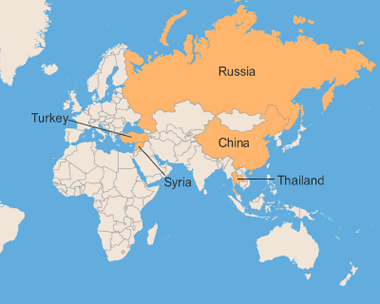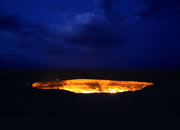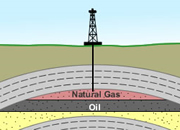Home » Rocks » Oil Shale » China, Russia, Syria, Thailand and Turkey
China, Russia, Syria, Thailand and Turkey Oil-Shale Deposits
Reprint of: United States Geological Survey Scientific Investigations Report 2005-5294
By John R. Dyni
| China, Russia, Syria, Thailand and Turkey |

Other countries with oil shales.
China
Two of China's principal resources of oil shale are those at Fushun and Maoming. The first commercial production of shale oil began at Fushun in 1930 with the construction of "Refinery No. 1;" this was followed by "Refinery No. 2," which began production in 1954, and a third facility that began producing shale oil at Maoming in 1963. The three plants eventually switched from shale oil to the refining of cheaper crude oil. A new plant for retorting oil shale was constructed at Fushun, with production beginning in 1992. Sixty Fushun-type retorts, each having a capacity of 100 tons of oil shale per day, produce 60,000 tons (about 415,000 bbls) of shale oil per year at Fushun (Chilin, 1995).
-Fushun
The Fushun oil-shale and coal deposit of Eocene age is located in northeastern China just south of the town of Fushun in Liaoning Province. Coal and oil shale are in a small outlier of Mesozoic and Tertiary sedimentary and volcanic rocks underlain by Precambrian granitic gneiss (Johnson, 1990). In this area, subbituminous to bituminous coal, carbonaceous mudstone and shale, and lenses of sandstone compose the Guchengzi Formation of Eocene age. The formation ranges from 20 to 145 m and averages 55 m in thickness. In the West Open Pit coal mine near Fushun, 6 coal beds are present, as well as a cannel coal 1 to 15 m thick that is used for decorative carving. The coal contains red to yellow gem-quality amber.
Overlying the Guchengzi Formation is the Eocene Jijuntun Formation that consists of oil shale of lacustrine origin. The oil shale is in gradational contact both with the underlying coal of the Guchengzi Formation and with the overlying lacustrine green mudstone of the Xilutian Formation. The Jijuntun Formation, which ranges from 48 to 190 m in thickness, is well exposed in the main West Open Pit coal mine where it is 115 m thick. The lower 15 m consists of low-grade light-brown oil shale and the remaining upper 100 m consists of richer grade brown to dark brown, finely laminated oil shale in beds of thin to medium thickness.
The oil shale contains abundant megafossils of fern, pine, oak, cypress, ginkgo, and sumac. Small fossil mollusks and crustaceans (ostracodes) are also present. The gradational contact between the oil shale and underlying coal indicates a depositional environment of an interior paludal basin that gradually subsided and was replaced by a lake in which the oil shale was deposited (Johnson, 1990, p. 227).
The oil yield of the shale ranges from about 4.7 to 16 percent by weight of the rock, and the mined shale averages 7 to 8 percent (~78-89 l/t) oil. In the vicinity of the mine, oil-shale resources are estimated at 260 million tons, of which 235 million tons (90 percent) are considered mineable. The total resource of oil shale at Fushun is estimated at 3,600 million tons.
The West Open Pit mine is located in a tightly folded syncline that trends east-west and is cut by several compressional and tensional faults. The pit is about 6.6 km long in an east-west direction, 2.0 km wide, and 300 m deep at the west end. In addition, two underground mines lie just east of the open-pit mine. The floor of the open-pit mine is on the south limb of the syncline and dips 22-45° to the north toward the fold axis. The overturned north flank of the syncline is bounded by an east-west thrust fault that places sandstone of the Cretaceous Longfengkan Formation in contact with the Jijuntun oil shale.
Coal mining at Fushun began about 1901. Production increased, first under the Russians and later under the Japanese, reaching a peak in 1945, then dropped sharply and remained low until 1953 when production increased again under the first 5-year plan of the People's Republic of China.
For the first 10 to 15 years of mining coal at Fushun, oil shale was discarded with the overburden. Production of oil shale began in 1926 under the Japanese and peaked in the early 1970s with about 60 million tons of oil shale mined annually then dropped to about 8 million tons in 1978. This reduction was partly due to increased discovery and production of cheaper crude oil within China. Baker and Hook (1979) have published additional details on oil-shale processing at Fushun.
| Oil Shale - Country Menu |
-Maoming
The Maoming oil-shale deposit, of Tertiary age, is 50 km long, 10 km wide, and 20 to 25 m thick. Total reserves of oil shale are 5 billion tons, of which 860 million tons are in the Jintang mine. The Fischer assay yield of the oil shale is 4 to 12 percent and averages 6.5 percent. The ore is yellow brown and the bulk density is about 1.85. The oil shale contains 72.1 percent ash, 10.8 percent moisture, 1.2 percent sulfur, with a heating value of 1,745 kcal/kg (dry basis). About 3.5 million tons of oil shale are mined yearly (Guo-Quan, 1988). The 8-mm fraction has a heating value of 1,158 kcal/kg and a moisture content of 16.3 percent. It cannot be retorted but is being tested for burning in a fluidized bed boiler. Cement is manufactured with a content of about 15 to 25 percent of the oil-shale ash.
Russia
More than 80 deposits of oil shale have been identified in Russia. The kukersite deposit in the Leningrad district (fig. 8) is burned as fuel in the Slansky electric power plant near St. Petersburg. In addition to the Leningrad deposit, the best deposits for exploitation are those in the Volga-Pechersk oil-shale province, including the Perelyub-Blagodatovsk, Kotsebinsk, and the Rubezhinsk deposits. These deposits contain beds of oil shale ranging from 0.8 to 2.6 m in thickness but are high in sulfur (4-6 percent, dry basis). The oil shale was used to fuel two electric power plants; however, the operation was shut down owing to high SO2 emissions. As of about 1995, an oil-shale plant at Syzran was processing not more than 50,000 tons of oil shale per year (Kashirskii, 1996).
Russell (1990) listed the resources of 13 deposits in the former Soviet Union, including the Estonian and Leningrad kukersite deposits and the Estonian Dictyonema Shale, at greater than 107 billion tons of oil shale.
Syria
Puura and others (1984) described oil shales from the Wadi Yarmouk Basin at the southern border of Syria that are presumably part of the Yarmouk deposit described above in northern Jordan. The strata are marine limestones (marinites) of Late Cretaceous to Paleogene age, consisting of carbonate and siliceous carbonate shelf deposits that are common in the Mediterranean area. Fossil remains constitute 10 to 15 percent of the rock. The mineral components of the oil shales are 78 to 96 percent carbonates (mostly calcite), with small amounts of quartz (1 to 9 percent), clay minerals (1 to 9 percent), and apatite (2 to 19 percent). The sulfur content is 0.7 to 2.9 percent. Oil yields by Fischer assay are 7 to 12 percent.
Thailand
Lacustrine oil-shale deposits of Tertiary age are near Mae Sot, Tak Province, and at Li, Lampoon Province. The Thai Department of Mineral Resources has explored the Mae Sot deposit with the drilling of many core holes. The oil shale is a lamosite similar in some respects to the Green River oil shale in Colorado. The Mae Sot deposit underlies about 53 km2 in the Mae Sot Basin in northwestern Thailand near the Myanmar (Burma) border. It contains an estimated 18.7 billion tons of oil shale, which is estimated to yield 6.4 billion barrels (916 million tons) of shale oil. The gross heating value ranges from 287 to 3,700 kcal/kg, the moisture content ranges from 1 to 13 percent, and the sulfur content is about 1 percent. The deposit at Li is probably also a lamosite but the reserves are small-estimated at 15 million tons of oil shale yielding 12-41 gallons of shale oil per ton of rock (50-171 l/t) (Vanichseni and others, 1988, p. 515-516).
Turkey
Lacustrine oil-shale deposits of Paleocene to Eocene age and of late Miocene age are widely distributed in middle and western Anatolia in western Turkey. The host rocks are marlstone and claystone in which the organic matter is finely dispersed. The presence of authigenic zeolites indicates probable deposition in hypersaline lacustrine waters in closed basins.
Data on the shale-oil resources are sparse because only a few of the deposits have been investigated. Güleç and Önen (1993) reported a total of 5.2 billion tons of oil shale in seven deposits with their ranges in calorific values; however, the shale-oil resources of these deposits are not reported. The oil-shale resources of Turkey may be large, but further studies are needed before reliable resource estimates can be made. On the basis of available data, total resources of in-situ shale oil for eight Turkish deposits are estimated at 284 million tons (about 2.0 billion bbls).
| More Oil |
 |
Horizontal Drilling |
 |
Oil and Gas Rights |
 |
Shale Gas Resources |
 |
Gifts That Rock |
 |
What is LNG? |
 |
The Doorway to Hell |
 |
Natural Gas Investing |
 |
Helium |

Find Other Topics on Geology.com:

|

| ||

|

| ||

|

| ||

|

|
